

|
by Joseph Brennan. Copyright 2001, 2002. |
Court StPassenger service: April 1936 - June 1946.Existing abandoned portions: Platform and 2 tracks in use as the Transit Museum. Touring: Near Borough Hall (2 3 4 5 trains), Court St (M N R trains), Jay St (A C F trains). Enter at northwest corner of Boerum Place and Schermerhorn St. The entire station is open as a museum, so both mezzanine and platform levels are accessible. Hoyt-Schermerhorn Sts platformsPassenger service: April 1936 - June 1946, September 1959 - March 1981.Existing abandoned portions: 2 platforms each between a track in service and a track not in regular service. Touring: A C G trains to Hoyt-Schermerhorn Sts station. The closed platforms can be easily seen from the open platforms, on the far side of the track used by A C trains. construction and operationCourt St and Hoyt-Schermerhorn Sts were part of the Independent subway system built by the Board of Transportation. Construction of the Fulton St line started in 1929 and it was open to Rockaway Ave in 1936. The Fulton St subway was planned as a replacement for the Fulton St elevated. It was a four-track main line intended to run eventually almost to the Nassau County line. In downtown Brooklyn, it veers off Fulton St at Lafayette Ave, because older subways already occupied the street. It runs instead under Schermerhorn St, parallel to Fulton St, which was already familiar to many riders because some trolley routes also ran in Schermerhorn St to escape congestion. Fulton St was the main shopping and theater street in downtown Brooklyn. Hoyt-Schermerhorn Sts station was to be the last express and local stop for Fulton St trains. The station also serves the Brooklyn-Queens Crosstown subway route, with four platforms and six tracks. The southern half of the station is under private property since Schermerhorn St is not wide enough for the large station. The station mezzanine is over the north half, under the street. The Fulton St locals were to run out to a terminal at Court St, the end of the business district. The expresses take a curve into Jay St and run to Manhattan. When the first part of the Fulton St line opened, the trains from Manhattan made all local stops since they were going only to Rockaway Ave. Court St was opened but used just for a shuttle train running to Hoyt-Schermerhorn Sts. Construction of the next portion of the line, to Euclid Ave, was delayed to 1938 because of financial problems during the Depression, and then work stopped in 1941 for the war. Fulton St express service did not start until 1949, and both local and express came from Manhattan. Court St is so close to stations with direct service to Manhattan that it never had much ridership, and it was closed shortly before the end of the war. Its closing also eliminated any use for the outer platforms at Hoyt-Schermerhorn Sts. For thirty years, Court St was almost unused. About halfway through this period, someone finally had the idea of capitalizing on it as a subway station set for movies, and an entrance at Boerum Place was reopened. It was perfect because trains could be put in it, and moved in and out as required for movie scenes, with no interference at all to regular train service. As part of the Bicentennial celebrations in 1976, the Transit Authority set up what was called the New York City Transit Exhibit, which opened on July 4. The Authority had already begun preserving selected cars with a view to a museum of some sort, and those cars in good condition were moved to the tracks at Court St. Other available items, like a collection of trolley and elevated car models, were set up in the large station mezzanine. Admission was one subway token. It was billed as temporary, but it has continued to the present day, now as the Transit Museum. It is not an abandoned station in the usual sense, but it does not have any regular train service. Special Nostalgia Train tours do operate in and out of the station a few times a year. The platforms at Hoyt-Schermerhorn Sts were used again from 1959 to 1981 for Aqueduct Racetrack special trains. An extra fare was charged, and it was convenient to segregate passengers who'd paid it to the separate platform. Hoyt-Schermerhorn Sts was the only stop between 42 St at 8 Ave and the track. Coming back from the track, the racetrack trains may have used the regular platform some of the time. The Hoyt-Schermerhorn Sts platforms are now sometimes used as a movie set. The outer tracks are never used in regular service, so, as formerly done at Court St, trains can be run in and out to meet the needs of movie scenes. The noise of other trains is inescapable, so sound for the scenes has to be dubbed later (as is often done anyway). |
diagram |
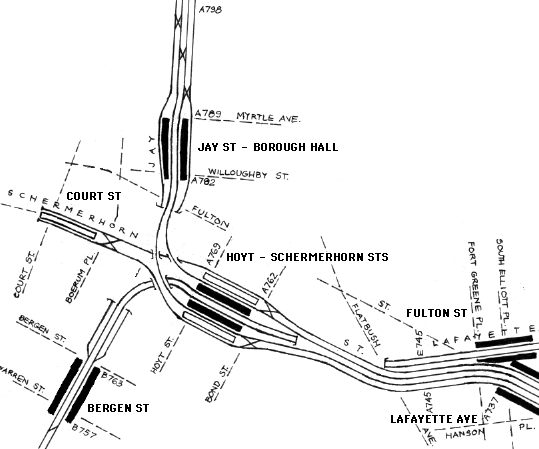
|
The tracks from Court St line up with the Fulton St local, and those from Manhattan via Jay St run into the Fulton St express. A curiosity is that the center tracks for the Crosstown line (G train) have no connection to the Fulton St tracks. |
|
There were numerous basically similar diagrams of the Independent subway. The IND was a pioneer in using train markers to identify a limited number of distinct services. The map shown here very clearly shows the HH shuttle and the A and C running through from Manhattan. The A train would have switched to the local tracks just past Hoyt-Schermerhorn, while the C would have stayed on the express tracks and reversed in the middle east of Lafayette Ave. This map also came in colors. |
|
Compared to the map above, the post-1940 IND division map is a step backwards. The map is clearly derived from the earlier one, but the marker letters are not shown, and a strangely elaborate symbol is used to show express stations. Dots in some station symbols show transfer points other than those to other subways of the "unified" system. |
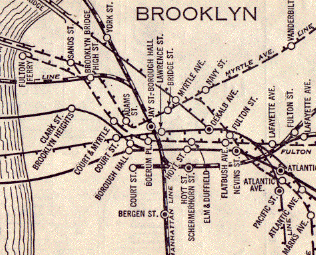
The WPA New York City Guide of 1939 included a rather crude fold-out subway map, sadly lacking in the modern reprints, that shows Court St station. |
|
It's not easy to spot the Court St shuttle in the subway route listings of the 1939 Geographia Complete Street Guide, but it's there. Most of the Crosstown line had opened in 1937, and the compilers had not yet listed the running times. |

|
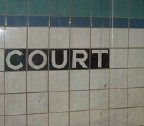 The station itself is one of the Transit Museum exhibits. The once-common black on white enamel station signs and original IND wall tile can still be seen. |
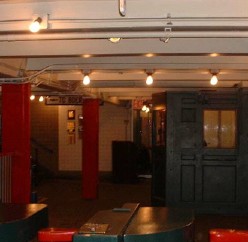 The museum entrance evokes classic IND style, with the bare light bulbs, wooden change booth, and old turnstiles. Three photos copyright by Harry Beck. From his Transit Museum page at http://www.nycrail.com. |
|
|
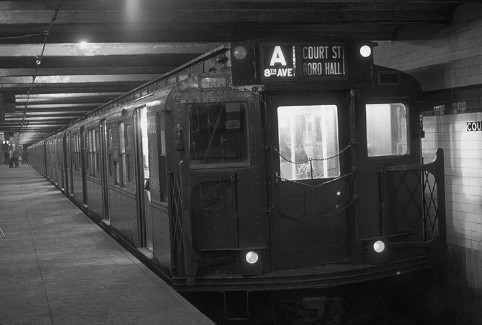
|
A train of Independent Subway cars stopped at Court St on a fan trip in May 1974, two years before the Transit Museum opened. Joe Testagrose collection. From the Transit Museum page at www.nycsubway.org. |
 See the Metropolitan Transit Authority's official Transit Museum home page for open hours and exhibit information. |
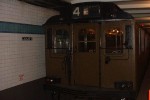 Photos of the Transit Museum can be found at The Other Side of the Tracks, www.nycrail.com. |

|
|
|